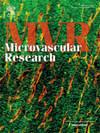dddit4敲低通过抑制NF-κB信号传导抑制静脉畸形进展作为潜在的治疗靶点。
IF 2.7
4区 医学
Q2 PERIPHERAL VASCULAR DISEASE
引用次数: 0
摘要
背景:本研究旨在探讨DNA损伤诱导转录本4 (DNA Damage Inducible Transcript 4, DDIT4)在静脉畸形(Venous Malformations, vm)发病中的调控作用及其分子机制,为潜在的靶向治疗提供基础实验依据。方法:通过生物信息学分析,确定dddit4是vm中关键的差异表达基因,并采用sgGSEA方法预测其潜在的生物学功能。采用免疫组织化学染色和免疫荧光法验证DDIT4的表达水平及其与血管密度的关系。建立慢病毒vm细胞模型,评估dddit4表达水平。我们评估了DDIT4敲低对vm细胞功能的影响,并通过转录组测序和Western blot分析获得了机制见解。使用3D vm细胞模型和敲除DDIT4的裸鼠异种移植进一步验证。此外,在DDIT4敲除的vm三维细胞模型和裸鼠异种移植中,通过脂多糖(LPS)激活NF-κB通路进行外源性功能拯救实验,进一步研究DDIT4的作用。结果:dddit4在vm组织中表达上调,与血管生成相关。DDIT4敲低增加细胞圆度,抑制增殖、迁移和NF-κB通路激活,阻断vm 3D模型血管生成和裸鼠异种移植瘤病变形成,同时抑制二者的NF-κB通路。NF-κB通路激活可恢复两种模型的血管生成。结论:DDIT4敲低可通过抑制NF-κB通路抑制vm进展,提示DDIT4可能是一个潜在的治疗靶点。本文章由计算机程序翻译,如有差异,请以英文原文为准。
DDIT4 knockdown suppresses venous malformation progression by inhibiting NF-κB signaling as a potential therapeutic target
Background
This study aims to investigate the regulatory role and underlying molecular mechanisms of DNA Damage Inducible Transcript 4 (DDIT4) in the pathogenesis of Venous Malformations (VMs), providing foundational experimental evidence for potential targeted therapies.
Methods
Bioinformatic analysis identified DDIT4 as a key differentially expressed gene in VMs, and the sgGSEA method was employed to predict its potential biological functions. Immunohistochemical staining and immunofluorescence were performed to validate the expression level of DDIT4 and its association with vascular density. A lentiviral VMs cell model was established to assess DDIT4 expression levels. The effects of DDIT4 knockdown on VMs cell function were evaluated, with mechanistic insights gained through transcriptome sequencing and Western blot analysis. Further validation was performed using 3D VMs cell models and nude mouse xenografts with DDIT4 knockdown. Additionally, exogenous functional rescue experiments were conducted by activating the NF-κB pathway with lipopolysaccharide (LPS) in DDIT4 knockdown VMs 3D cell models and nude mouse xenografts to further investigate the role of DDIT4.
Results
DDIT4 was upregulated in VMs tissues and correlated with angiogenesis. DDIT4 knockdown increased cell roundness, inhibited proliferation, migration, and NF-κB pathway activation, and blocked angiogenesis in VMs 3D models and lesion formation in nude mouse xenografts, while suppressing the NF-κB pathway in both. NF-κB pathway activation restored angiogenesis in both models.
Conclusions
DDIT4 knockdown inhibits VMs progression by suppressing the NF-κB pathway, suggesting that DDIT4 may serve as a potential therapeutic target.
求助全文
通过发布文献求助,成功后即可免费获取论文全文。
去求助
来源期刊

Microvascular research
医学-外周血管病
CiteScore
6.00
自引率
3.20%
发文量
158
审稿时长
43 days
期刊介绍:
Microvascular Research is dedicated to the dissemination of fundamental information related to the microvascular field. Full-length articles presenting the results of original research and brief communications are featured.
Research Areas include:
• Angiogenesis
• Biochemistry
• Bioengineering
• Biomathematics
• Biophysics
• Cancer
• Circulatory homeostasis
• Comparative physiology
• Drug delivery
• Neuropharmacology
• Microvascular pathology
• Rheology
• Tissue Engineering.
 求助内容:
求助内容: 应助结果提醒方式:
应助结果提醒方式:


